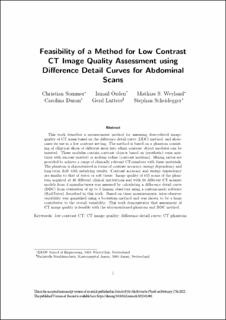Please use this identifier to cite or link to this item:
https://doi.org/10.21256/zhaw-24610Full metadata record
| DC Field | Value | Language |
|---|---|---|
| dc.contributor.author | Sommer, Christian | - |
| dc.contributor.author | Özden, Ismail | - |
| dc.contributor.author | Weyland, Mathias S. | - |
| dc.contributor.author | Duran, Carolina | - |
| dc.contributor.author | Lutters, Gerd | - |
| dc.contributor.author | Scheidegger, Stephan | - |
| dc.date.accessioned | 2022-03-17T09:25:26Z | - |
| dc.date.available | 2022-03-17T09:25:26Z | - |
| dc.date.issued | 2022-02-17 | - |
| dc.identifier.issn | 0939-3889 | de_CH |
| dc.identifier.issn | 1876-4436 | de_CH |
| dc.identifier.uri | https://digitalcollection.zhaw.ch/handle/11475/24610 | - |
| dc.description.abstract | This work describes a measurement method for assessing dose-related image-quality of CT scans based on the difference detail curve (DDC) method, and showcases its use in a low contrast setting. The method is based on a phantom consisting of elliptical slices of different sizes into which contrast object modules can be inserted. These modules contain contrast objects based on (synthetic) resin mixtures with sucrose (native) or sodium iodine (contrast medium). Mixing ratios are provided to achieve a range of clinically relevant CT-numbers with these materials. The phantom is characterized in terms of contrast accuracy, energy dependency and long-term drift with satisfying results. Contrast accuracy and energy dependency are similar to that of water or soft tissue. Image quality of 655 scans of the phantom acquired at 30 different clinical institutions and with 16 different CT scanner models from 4 manufacturers was assessed by calculating a difference detail curve (DDC) from evaluation of up to 5 human observers using a custom-made software (RadiVates) described in this work. Based on these measurements, inter-observer variability was quantified using a bootstrap method and was shown to be a large contributor to the overall variability. This work demonstrates that assessment of CT image quality is feasible with the aforementioned phantom and DDC method. | de_CH |
| dc.language.iso | en | de_CH |
| dc.publisher | Elsevier | de_CH |
| dc.relation.ispartof | Zeitschrift für Medizinische Physik | de_CH |
| dc.rights | http://creativecommons.org/licenses/by-nc-nd/4.0/ | de_CH |
| dc.subject | CT image quality | de_CH |
| dc.subject | CT phantom | de_CH |
| dc.subject | Difference detail curve | de_CH |
| dc.subject | Low contrast CT | de_CH |
| dc.subject.ddc | 510: Mathematik | de_CH |
| dc.subject.ddc | 616: Innere Medizin und Krankheiten | de_CH |
| dc.title | Feasibility of a method for low contrast CT image quality assessment using difference detail curves for abdominal scans | de_CH |
| dc.type | Beitrag in wissenschaftlicher Zeitschrift | de_CH |
| dcterms.type | Text | de_CH |
| zhaw.departement | School of Engineering | de_CH |
| zhaw.organisationalunit | Institut für Angewandte Mathematik und Physik (IAMP) | de_CH |
| dc.identifier.doi | 10.1016/j.zemedi.2022.01.001 | de_CH |
| dc.identifier.doi | 10.21256/zhaw-24610 | - |
| dc.identifier.pmid | 35184974 | de_CH |
| zhaw.funding.eu | No | de_CH |
| zhaw.issue | 2 | de_CH |
| zhaw.originated.zhaw | Yes | de_CH |
| zhaw.pages.end | 217 | de_CH |
| zhaw.pages.start | 209 | de_CH |
| zhaw.publication.status | acceptedVersion | de_CH |
| zhaw.volume | 32 | de_CH |
| zhaw.publication.review | Peer review (Publikation) | de_CH |
| zhaw.author.additional | No | de_CH |
| zhaw.display.portrait | Yes | de_CH |
| Appears in collections: | Publikationen School of Engineering | |
Files in This Item:
| File | Description | Size | Format | |
|---|---|---|---|---|
| 2022_Sommer-etal_Feasibility-low-contrast-CT-image-quality-assessment.pdf | Accepted Version | 1.87 MB | Adobe PDF |  View/Open |
Show simple item record
Sommer, C., Özden, I., Weyland, M. S., Duran, C., Lutters, G., & Scheidegger, S. (2022). Feasibility of a method for low contrast CT image quality assessment using difference detail curves for abdominal scans. Zeitschrift Für Medizinische Physik, 32(2), 209–217. https://doi.org/10.1016/j.zemedi.2022.01.001
Sommer, C. et al. (2022) ‘Feasibility of a method for low contrast CT image quality assessment using difference detail curves for abdominal scans’, Zeitschrift für Medizinische Physik, 32(2), pp. 209–217. Available at: https://doi.org/10.1016/j.zemedi.2022.01.001.
C. Sommer, I. Özden, M. S. Weyland, C. Duran, G. Lutters, and S. Scheidegger, “Feasibility of a method for low contrast CT image quality assessment using difference detail curves for abdominal scans,” Zeitschrift für Medizinische Physik, vol. 32, no. 2, pp. 209–217, Feb. 2022, doi: 10.1016/j.zemedi.2022.01.001.
SOMMER, Christian, Ismail ÖZDEN, Mathias S. WEYLAND, Carolina DURAN, Gerd LUTTERS und Stephan SCHEIDEGGER, 2022. Feasibility of a method for low contrast CT image quality assessment using difference detail curves for abdominal scans. Zeitschrift für Medizinische Physik. 17 Februar 2022. Bd. 32, Nr. 2, S. 209–217. DOI 10.1016/j.zemedi.2022.01.001
Sommer, Christian, Ismail Özden, Mathias S. Weyland, Carolina Duran, Gerd Lutters, and Stephan Scheidegger. 2022. “Feasibility of a Method for Low Contrast CT Image Quality Assessment Using Difference Detail Curves for Abdominal Scans.” Zeitschrift Für Medizinische Physik 32 (2): 209–17. https://doi.org/10.1016/j.zemedi.2022.01.001.
Sommer, Christian, et al. “Feasibility of a Method for Low Contrast CT Image Quality Assessment Using Difference Detail Curves for Abdominal Scans.” Zeitschrift Für Medizinische Physik, vol. 32, no. 2, Feb. 2022, pp. 209–17, https://doi.org/10.1016/j.zemedi.2022.01.001.
Items in DSpace are protected by copyright, with all rights reserved, unless otherwise indicated.